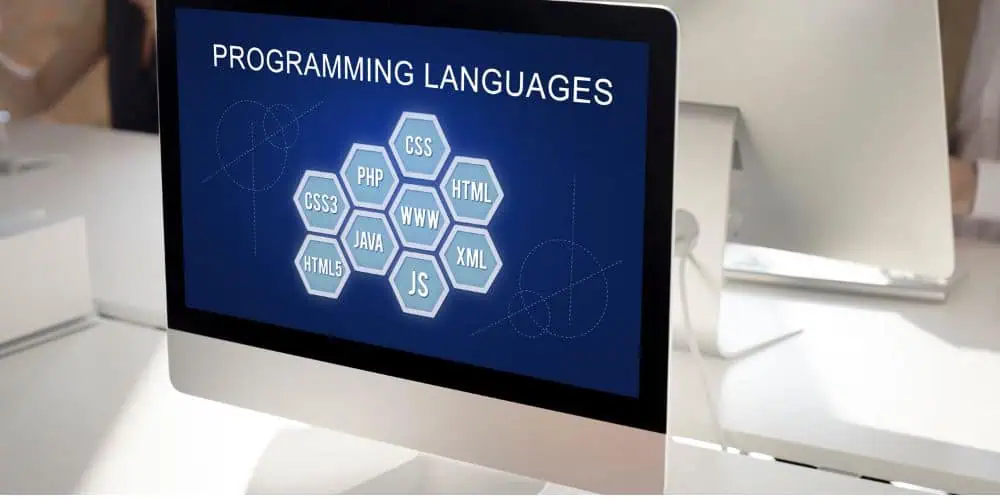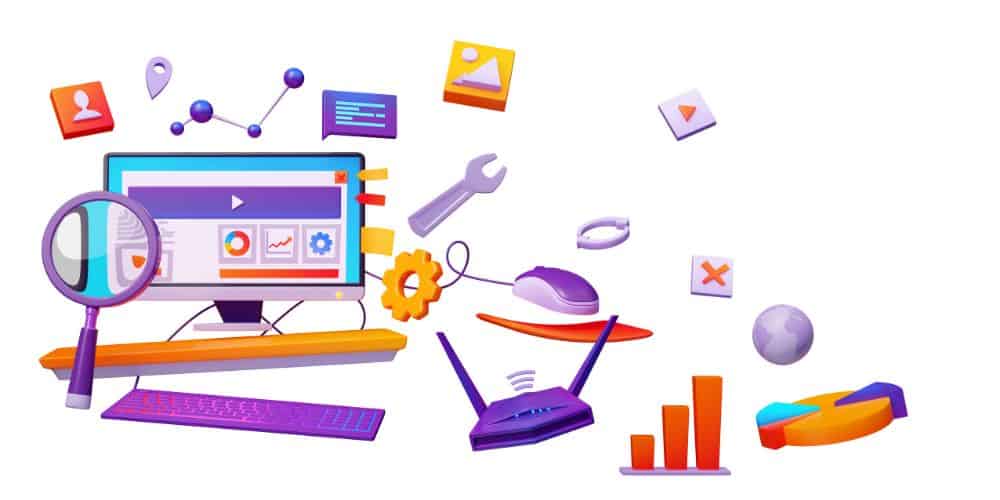
Do you know that the first programming language was introduced in 1883? Since then, coding has evolved significantly, with numerous languages emerging. When you browse the internet, you might wonder, “What makes all these websites work?” The answer comes down to the top 10 web development languages. If you want to build amazing websites, these tools are your starting point.
Many people feel lost when they first try web coding. It all seems confusing. Have you ever stared at code and thought, “Where do I even begin?”
But you do not need to worry. In this guide, we will provide a detailed explanation of every aspect. Our goal is to help everyone, even beginners, in Canada.
The Essential Web Development Languages & Tools that Power the Internet
The internet is like a tech house. Every website is a room. To build these rooms, we need a toolkit. This toolkit is a collection of the top 10 technologies for web development. You can also think of it as a builder’s toolbox because every tool has a unique job.
Some of these tools are called programming languages. Others are called frameworks or software. So, you must know what each one does. Choosing the right ones makes your job much easier and your website much better.
Understanding Languages, Frameworks, and Development Software
Let’s clear up a common confusion. What are the differences between languages, frameworks, and the best software for web application development?
| Category | Technology | Role/Description | Use Case/When to Use |
| Languages | HTML/CSS | Structure (HTML) and style (CSS) of web pages | Used in the front-end to structure and style content. |
| JavaScript | Dynamic behavior and interactivity | Core language for client-side interactions, handling UI updates, animations, and form validations. | |
| Python | Back-end scripting, web servers, data processing | Used for server-side logic, APIs, and handling data. | |
| Ruby | Back-end scripting and web app development | Often used for web development with Ruby on Rails. | |
| PHP | Server-side scripting for dynamic web pages | Popular for handling back-end logic, often with WordPress. | |
| SQL | Database querying language | Used to interact with databases for storing user data, stream info, etc. | |
| Frameworks | React | Front-end JavaScript library for building user interfaces | Used for building dynamic and responsive user interfaces. |
| Vue.js | Front-end JavaScript framework | For building single-page applications (SPAs) and dynamic UIs. | |
| Node.js | JavaScript runtime for server-side logic | Enables running JavaScript on the server, often used for APIs and real-time applications. | |
| Django | Python web framework for back-end development | Great for fast development with secure back-end features. | |
| Flask | Lightweight Python web framework | Ideal for smaller apps, APIs, or projects that don’t need full-featured frameworks. | |
| Ruby on Rails | Web application framework for Ruby | Convention over configuration; ideal for rapid development. | |
| Laravel | PHP framework for modern web applications | Used for building robust, secure back-end applications. | |
| Express.js | Minimalist Node.js framework for back-end | Used for building fast, lightweight web servers and APIs. | |
| Development Software | VS Code | Code editor with support for extensions and debugging | Lightweight, highly customizable IDE used for coding in JavaScript, Python, etc. |
| PyCharm | Python IDE with rich features for Python development | Excellent for Python development, debugging, and testing. | |
| Sublime Text | Text editor with support for many languages and plugins | Ideal for quick edits and lightweight coding tasks. | |
| Git | Version control system | Essential for managing code changes, collaboration, and deployment. | |
| Docker | Containerization platform | Useful for setting up consistent development and production environments. | |
| Postman | API testing and development tool | Ideal for testing and debugging APIs before integration. | |
| Jira | Project management and issue tracking | Used for managing tasks, sprints, and development workflows. | |
| Figma/Sketch | UI/UX design tools | Used for creating and prototyping designs for web and mobile interfaces. |
Key Notes:
- Languages are the main tools. It is used to build different parts of a website. It includes the front-end (what users see), back-end (server-side), and databases (where data is stored).
- Frameworks help organize your code and make development faster. They offer pre-built templates and features, so you don’t have to start from scratch.
- Development software includes tools that help you write code, keep track of changes, design your app or website, and manage your project. These tools make the entire development process smoother and more efficient.
How Does Technology Stack Impact Success?

A tech stack is like the foundation of a development. It shapes how everything functions and how smoothly the process runs. The right combination of tools and technologies can make or break a project.
When you choose the right tech stack, you set yourself up for success. It ensures your team has the best tools to build a reliable, scalable product.
For example, a well-chosen stack can speed up development. It lets developers work efficiently, saving time and resources. It also ensures your platform is fast, secure, and easy to maintain.
On the other side, a poor tech stack can lead to delays, bugs, and even security risks. It can cause frustration for the team and a bad experience for the user. Choosing the wrong tools might also make it harder to scale in the future.
The tech stack impacts how quickly you can launch, how well your product performs, and how easily you can fix issues down the road. It’s not just about picking popular technologies. It is about finding the ones that fit your specific needs.
Get the tech stack right, and success will follow. Get it wrong, and you’ll face a lot of unnecessary problems.
Frontend vs. Backend Development: What They are and Why Both are Crucial
Let’s make it simple. Every website has two sides:
| Aspect | Frontend Development | Backend Development |
| What it is | Deals with the user interface (UI) and user experience (UX). | Focuses on the server, database, and logic behind the scenes. |
| Languages Used | HTML, CSS, JavaScript, TypeScript | Python, Java, PHP, Ruby, Node.js, C#, SQL |
| Role | Builds everything the user interacts with directly. | Manages databases, servers, and logic that power the frontend. |
| Responsibilities | – Designing layouts and UI elements.- Making the site interactive.- Ensuring responsiveness (works on all devices). | – Handling user requests.- Storing and retrieving data from databases.- Managing authentication and security. |
| Tools/Frameworks | React, Angular, Vue.js, SASS, Bootstrap | Django, Flask, Ruby on Rails, Express.js, Laravel |
| Focus | Visuals, layout, and interactivity. | Data processing, logic, and server-side functionality. |
| User Interaction | Direct interaction (buttons, menus, images, etc.). | Indirect interaction (processing data sent from the frontend). |
| Example | What users see and interact with on a website or app. | Servers, databases, APIs, and everything that happens behind the scenes. |
| Tools for Testing | Browser developer tools, Jest (for JavaScript). | Postman (API testing), unit testing frameworks. |
| Skills Required | Creativity, design sense, and knowledge of UI/UX principles. | Problem-solving, knowledge of databases, and server-side logic. |
Knowing both sides helps you make better tech choices. Some web development languages work best on the front, others on the back.
The Role of Development Software: Building the Digital World
Development software is all about turning ideas into digital experiences. Working on websites gets easier with the right tools. Code editors, version control, and package managers, together, make up the best software for web application development. They help you work faster, find mistakes, and team up with others.
Why Does It Matter?
Consider you want to build a house. You need the right tools, including a hammer, nails, measuring tape, etc. Similarly, to build a robust web application, developers depend on development software to bring their ideas to life. Without it, creating complex websites or apps would be slow and inefficient.
How Does It Help?
1. Efficiency
With the right development tools, developers can work faster and more accurately. They don’t have to reinvent the wheel every time they build a feature.
2. Collaboration
Many development tools are designed to help teams work together, making it easier to coordinate on large projects.
3. Debugging
Development software often comes with built-in debugging tools that help developers find and fix errors in their code quickly.
4. Customization
It allows developers to customize how an app or website behaves, ensuring it meets the needs of users.
Want a web app that works seamlessly across all platforms? Our full-stack development services provide a complete solution, from front-end to back-end. We build apps that are scalable, secure, and high-performing.
The Top 10 Web Development Languages and Technologies

Here’s the list you need. Each tool or language here is used by real developers every day. Mastering these opens countless doors.
1. JavaScript: The Language of the Web
Primary Use: Frontend and Backend
JavaScript leads any list of the top 10 web development languages. Why? Because it runs in every browser. Every click, form, or animation on a webpage most likely uses JavaScript.
Why it’s essential
- It makes websites interactive.
- It works on both the frontend and backend (thanks to Node.js).
- Every major website uses it.
If you want a job in coding, start here. Learning JavaScript puts you in touch with the top technologies for web development everywhere.
2. HTML/CSS: The Skeleton and Skin of Every Website
Primary Use: Frontend Structure and Styling
No website exists without these. HTML gives a website structure. CSS adds colors, fonts, and designs.
Why essential
- They are the “bones and skin” of any website you build.
- Even the most trending web development technologies need them.
HTML lets you say, “Here’s a heading.” CSS says, “Make it blue and bold!” You cannot skip these if you want to master web development.
3. Python: The Versatile All-Rounder
Primary Use: Backend, Data Science, AI
Python is a star in the top 10 web development languages for a simple reason—it’s so easy to read.
Why it’s popular
- Clean, readable code.
- Huge library collection for all tasks.
- Used for backend servers, AI, and data.
4. TypeScript: JavaScript with Enhanced Reliability
Primary Use: Frontend and Backend
TypeScript is like JavaScript’s smarter cousin. It adds safety and helps catch mistakes early.
Why it’s trending
- Prevents errors in big projects.
- Helps teams work together.
- Growing fast in the list of top 10 technologies for web development.
If you like JavaScript, you will love TypeScript for complex work.
5. SQL: The Database Communication Standard
Primary Use: Database Management
All the data you see on websites has to be stored somewhere. SQL is the magic language that interacts with these databases.
Why it’s essential
- Runs the world’s databases.
- Simple questions fetch complex data.
- Used everywhere, from banks to blogs.
Learning SQL connects you to any data-driven project in Canada.
6. Java: The Enterprise-Grade Workhorse
Primary Use: Large-Scale Backend Systems
Java might seem old, but it is solid and trusted. Many banks, government sites, and huge companies bet on Java.
Why it remains popular
- Runs anywhere (Windows, Mac, Linux).
- Reliable and secure.
- Powers enterprise websites—especially those handling lots of users.
Java remains high in lists of the most popular backend languages and the top 10 web development languages.
7. PHP: The Web-First Server-Side Language
Primary Use: Backend Web Development
PHP is everywhere. In fact, it powers most of the world’s websites, including WordPress.
Why it’s widely used:
- Easy to learn and set up.
- Perfect for small business sites and blogs.
- Works great with many best software for web application development platforms.
If you want a fast start in the web world, don’t skip PHP.
8. Node.js: JavaScript on the Server
Primary Use: Backend
Node.js lets you write server code in JavaScript. Now you can use one language for everything!
Why it’s powerful
- Fast and efficient.
- Great for chat apps, games, and real-time tools.
- Helps with modern full-stack development services.
Many startups and big web projects in Canada use Node.js.
9. C#: The Microsoft Ecosystem Specialist
Primary Use: Enterprise Backend
C# is Microsoft’s answer for business websites. Well-integrated with Windows tools, it’s reliable and strong.
Why it’s relevant
- Tightly linked to the .NET framework.
- Lots of jobs for C# and .NET in Canadian companies.
- Perfect for big, complex sites and products.
If you like the Microsoft ecosystem, C# is key in your toolbox.
10. Ruby: The Developer-Friendly Choice
Primary Use: Backend Web Development
Ruby is famous for its friendly style and the Rails framework, which helps build web apps super fast.
Why it’s valued
- Clean, readable code.
- A favorite for quick startups and MVPs.
- Great community support.
Ruby’s productivity means faster launch times for your website or app.
| No. | Language | Core Features | Example of Web Application |
| 1 | JavaScript | – Client-side scripting- Dynamic content- Event handling | Social media (e.g., Facebook, Twitter) |
| 2 | HTML/CSS | – HTML structures content- CSS styles web pages- Responsive design | Blog sites (e.g., WordPress, Medium) |
| 3 | Python | – Simple syntax- Great for back-end- Web frameworks like Django | Data apps (e.g., Instagram, Pinterest) |
| 4 | TypeScript | – Static typing- Improved scalability- Works with JS frameworks | Enterprise apps (e.g., Slack, VS Code) |
| 5 | SQL | – Data management- Complex queries- Works with relational databases | Database apps (e.g., Banking, Amazon) |
| 6 | Java | – Object-oriented- Platform-independent- High performance | Enterprise apps (e.g., LinkedIn, Uber) |
| 7 | PHP | – Server-side scripting- Dynamic content- Works with MySQL | CMS (e.g., WordPress, Wikipedia) |
| 8 | Node.js | – JavaScript on server- Asynchronous events- Real-time apps | Real-time apps (e.g., LinkedIn, Trello) |
| 9 | C# | – Object-oriented- Rich libraries- Cross-platform (with .NET Core) | Enterprise apps (e.g., Microsoft 365, Stack Overflow) |
| 10 | Ruby | – Simple syntax- Convention over configuration- Fast development | Web apps (e.g., Airbnb, GitHub) |
Essential Software for Web Application Development
Knowing the top 10 web development languages is just one piece of the puzzle. The best software for web application development makes working with these languages much easier. Let’s talk about the important tools every developer should know.
1. Code Editors and IDEs
- Visual Studio Code: Free, fast, and powerful.
- Sublime Text: Great for quick edits.
- JetBrains IDEs: Offer smart code suggestions and support for many languages.
2. Version Control Systems
- Git: Essential for tracking changes.
- GitHub/GitLab: Make teamwork simple.
3. Package Managers
- npm: For JavaScript tools and libraries.
- Composer: For PHP packages.
4. Local Development Environments
- Docker: Makes it easy to work on different computers.
- XAMPP: A Fast way to start local servers for testing.
- Laravel Valet: For Mac users who love PHP.
Using these as part of your stack means you work faster, make fewer errors, and build stronger websites.
How to Choose the Right Technology for Your Project?

With so many choices, picking from the top 10 web development languages can feel tough. Keep it easy with these steps:
- Consider Your Project Scope: A blog might only need PHP and HTML/CSS. A bank app could need Java or C#.
- Evaluate Team Expertise: Use what you or your team knows best from the top 10 technologies for web development.
- Analyze Long-Term Maintenance: Pick popular languages with good support. You want a big community in Canada.
- Assess Performance Needs: Fast, scalable apps need the right mix of speed and power.
If you’re unsure, talk to an agency offering cross-platform mobile app development services. They can help you pick the best tools for your project. And ensure your app works well on different platforms.
The Future-Proof Nature of These Technologies
The top web development languages have lasted for good reasons.
- Constant updates.
- Massive online communities.
- Support for new trends like mobile-first design and cloud APIs.
Even as new frameworks pop up, core languages like JavaScript and Python keep getting better and easier to use.
This means your skills stay valuable—no matter how the internet changes.
How do These Tools Adapt to Modern Trends?
Development tools are changing to keep up with today’s technology. They are faster, easier to use, and help developers work together.
First, Cloud Integration has made teamwork better. Tools like GitHub and Visual Studio Code allow developers to share and update their code from anywhere, using the cloud.
Next, Automation saves time and reduces mistakes. Tools like Jenkins and Docker handle tasks like testing and deployment automatically, so developers don’t have to do everything by hand.
Also, mobile-first design is very important now. Tools like Figma help developers create apps that look great on any device, whether it’s a phone or a computer.
Conclusion: Building Your Web Development Toolkit
Choosing the right web development language in 2025 depends on the specifics of your project. It’s important to think about things like your existing tech stack, the skills of your development team, and how scalable or high-performing your app needs to be. Each programming language has its own strengths and ideal use cases.
For front-end development, the most common combo is HTML, CSS, and JavaScript. JavaScript, in particular, stands out as a super flexible and in-demand language.
When it comes to back-end development, languages like Python, Java, and PHP are popular. These languages are easy to learn, scalable, and flexible.
So, before you decide on a language for your project, ensure to consider these key factors to ensure you choose the best fit for your web development needs.
Ready to Start Your Web Development Project?
Not sure which technologies fit your project best? Our experts can help! We specialize in AI software development services for Canadian businesses.
What You’ll Get:
- Technology stack recommendation
- Project roadmap and timeline
- Development cost estimation
Want to create a successful SaaS platform? Partner with a SaaS development agency for expert solutions that fit your needs. Let’s talk about how we can make your project a reality.










